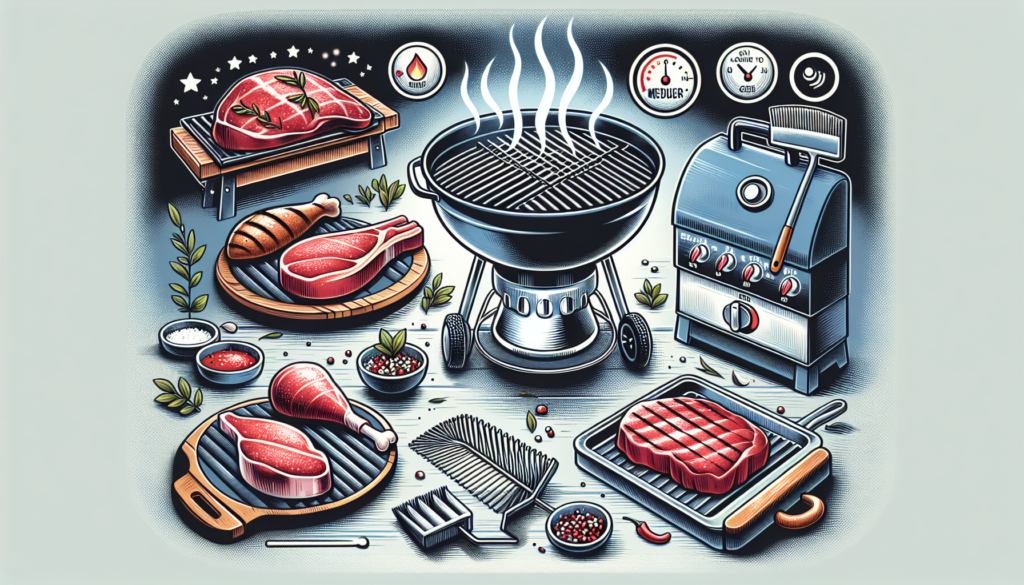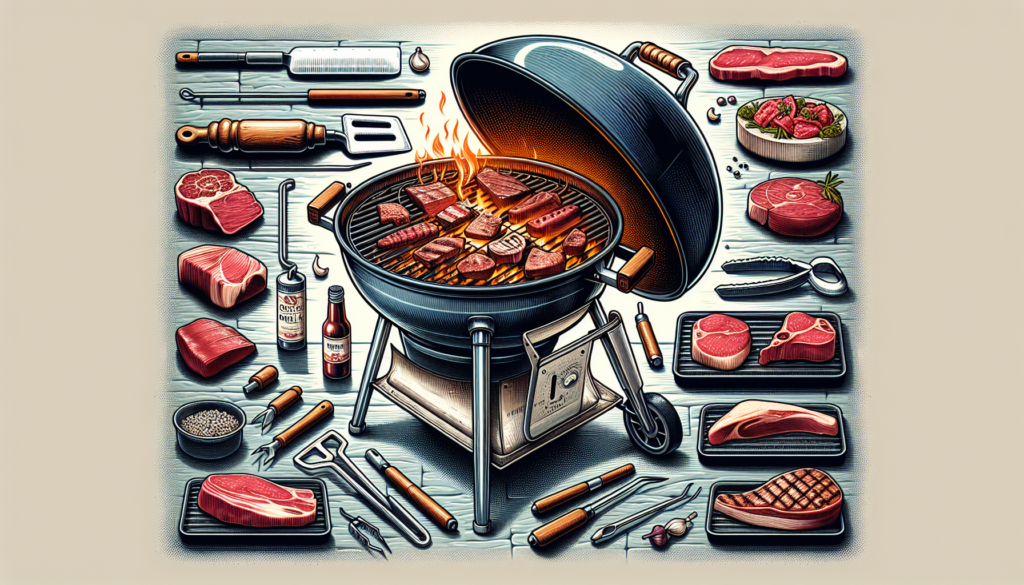Grilling is a fantastic way to enjoy delicious and flavorful meals during the summer season. Whether you’re a novice or have limited experience with grilling, these 10 essential tips are here to help you become a grilling pro in no time! From selecting the right type of grill to mastering the perfect temperature, this article will provide you with all the necessary guidance you need to get started on your grilling adventure. Get ready to elevate your outdoor cooking skills and impress your friends and family with mouthwatering grilled dishes!

Choosing the right grill
When it comes to choosing the right grill, there are a few factors to consider. First, think about the type of grill that best suits your needs. There are several options to choose from, including gas grills, charcoal grills, and electric grills. Gas grills are convenient and easy to use, while charcoal grills offer a smoky flavor that many people love. Electric grills are perfect for those who live in apartments or condominiums where open flames may not be allowed. Consider your grilling preferences and lifestyle to make the right choice.
Once you’ve decided on the type of grill, it’s important to evaluate the features. Look for grills with adjustable heat settings, built-in thermometers, and easy-to-clean grates. Additional features like side burners, rotisserie attachments, and warming racks can add versatility to your grilling experience. Take your time to research different grill models and make a well-informed decision based on your specific needs and budget.
Another crucial aspect to consider is the fuel type. Gas grills use either propane or natural gas, while charcoal grills require charcoal briquettes or lump charcoal. Each type of fuel has its own pros and cons. Propane and natural gas offer convenience and quick heat, while charcoal provides that authentic smoky flavor. Consider factors such as availability, cost, and personal preference when choosing the fuel type for your grill.
Preparation and safety
Before firing up the grill, it’s important to read the manual that comes with your specific grill model. The manual will provide valuable information on assembly, operation, and maintenance. Take the time to familiarize yourself with the safety precautions and operating instructions to ensure a safe and enjoyable grilling experience.
Cleaning the grill is another essential step to prepare for grilling. Remove any debris or grease buildup from the grates and burners using a grill brush or scraper. This will prevent flare-ups and ensure even heat distribution. Additionally, regularly cleaning your grill will prolong its lifespan and maintain its performance.
Proper ventilation is crucial when grilling. Ensure that your grill is located in a well-ventilated area, away from any flammable materials. Grilling in an open space or in a well-ventilated outdoor area will prevent the buildup of harmful gases and minimize the risk of accidents.
Understanding heat control
Controlling the heat on your grill is essential for achieving perfectly cooked food. Familiarize yourself with the concepts of direct and indirect heat. Direct heat is when you cook food directly over the flame or heat source, while indirect heat is when you cook food alongside or away from the flame, using the residual heat.
Using the grill lid is another important technique for heat control. Closing the lid traps heat and allows for even cooking. It also helps retain moisture and enhance flavors by circulating the smoke around the food. Make sure to monitor the internal temperature using a meat thermometer to ensure the desired doneness.
Managing temperature zones on your grill is crucial for cooking different types of food simultaneously. By creating different heat zones on your grill, you can sear meats over high heat while allowing delicate foods to cook gently over lower heat. This technique ensures that everything is cooked to perfection without any risk of overcooking or undercooking.
Selecting the right protein
Choosing the right protein is key to a delicious grilled meal. When it comes to beef, opt for cuts that are well-marbled and have a good amount of fat, such as ribeye or New York strip steak. For poultry, skin-on chicken thighs or drumsticks are ideal as they’re more flavorful and less likely to dry out on the grill. For pork, try bone-in chops or tenderloins for maximum tenderness and juiciness.
Marinating your protein is a great way to add flavor and enhance the juiciness. Create your own marinades using ingredients like citrus juices, herbs, spices, and olive oil. Allow the meat to soak in the marinade for at least 30 minutes, or overnight for a more intense flavor.
If you’re grilling poultry or lean cuts of meat, consider brining them beforehand. Brining involves soaking the meat in a mixture of salt, sugar, and water to improve tenderness and juiciness. The salt helps the meat retain moisture, resulting in a more succulent final product.

Mastering seasoning techniques
Seasoning your grilled food can take it to the next level. Rubs are a dry mixture of herbs, spices, and salt that are massaged onto the meat before grilling. They create a crust on the surface, adding flavor and texture. Experiment with different rub combinations to find your favorites.
Marinades are another great way to infuse flavors into your grilled food. Unlike rubs, marinades are liquid-based and typically consist of a combination of acids (such as vinegar or citrus juice), oils, herbs, and spices. Allow your protein to marinate for at least 30 minutes, or up to overnight, to achieve maximum flavor.
Spice blends are an exciting way to experiment with flavors. Create your own blends by combining different spices, herbs, and even dried fruits. Use these blends to season your meat before grilling or as a finishing touch to add an extra burst of flavor.
Essential grilling tools
Having the right tools is essential for a successful grilling experience. Grilling tongs are a must-have tool for flipping and lifting food on the grill. Look for tongs with long handles and a sturdy grip to keep your hands safe from the heat.
A grill brush is another essential tool for keeping your grill clean. Use it to remove any debris or charred residue from the grates after each use. Regularly cleaning your grill will prevent the buildup of grease and ensure optimal performance.
Investing in a meat thermometer is crucial for grilling meat to the desired doneness. This tool helps you monitor the internal temperature of the meat, ensuring it’s cooked to perfection. Different proteins have specific temperature guidelines, so refer to a meat doneness chart to achieve the desired results.
Optimizing grilling techniques
Preheating the grill is a crucial step for achieving the perfect sear and ensuring even cooking. Allow your grill to preheat for at least 10-15 minutes before placing any food on the grates. This will help prevent sticking and ensure beautiful grill marks.
Creating those coveted grill marks on your food is not only visually appealing but also adds a touch of flavor. Achieving grill marks is easy; simply place your protein on the hot grill grates at a diagonal angle and let it sear for a few minutes. Rotate the protein 90 degrees and continue to cook until desired doneness is reached.
Understanding doneness indicators is important to guarantee food safety and achieve the desired level of doneness. Use a meat thermometer to check the internal temperature of your protein. Fish should reach 145°F (63°C), chicken and turkey should reach 165°F (74°C), while beef and pork can vary depending on personal preference.
Proper fuel management
For charcoal grilling, it’s important to follow a few tips to optimize your grilling experience. Use a chimney starter to light the charcoal, and avoid using lighter fluid, as it can leave a chemical taste on your food. Once the charcoal is hot and covered in white ash, spread it out evenly in the grill to create an even heat source.
Gas grilling requires proper fuel management as well. Always ensure that your gas tank is filled and that the connections are secure. Check for any leaks by brushing soapy water on the connections; if bubbles form, there’s a leak, and you should address it before proceeding. Adjust the heat settings on your grill to achieve the desired temperature.
Wood pellet grills are becoming increasingly popular. These grills use wood pellets as fuel, which adds a unique smoky flavor to your food. Ensure you have enough pellets for your grilling session, and carefully follow the instructions for your specific grill model to ensure proper operation.
Maintaining food safety
Food safety is paramount when grilling, as improper handling can lead to foodborne illnesses. Prevent cross-contamination by using separate cutting boards, utensils, and platters for raw and cooked foods. Wash your hands thoroughly before and after handling raw meat to avoid spreading bacteria.
Storing and handling meat properly is another crucial aspect of food safety. Keep raw meat refrigerated until you’re ready to grill, and never leave cooked food sitting out for more than two hours. Use clean platters and utensils to transfer cooked meat, and discard any leftovers that have been left out for an extended period.
Monitoring internal temperatures is the best way to ensure that your food is cooked to the proper temperature. Use a meat thermometer to check the internal temperature of your protein at its thickest part. Refer to temperature guidelines for various meats to ensure that they are fully cooked and safe to consume.
Resting and serving grilled food
Allowing your meat to rest is an important step before slicing and serving. Resting allows the juices to redistribute evenly, resulting in a more flavorful and tender final product. Tent the meat loosely with foil and let it rest for about 5-10 minutes to achieve the best results.
Slicing techniques can make a significant difference in the presentation and texture of your grilled food. Use a sharp knife to slice against the grain for maximum tenderness. Cutting thinner slices will also help your protein stay moist and juicy.
When it comes to garnishing and presentation, the possibilities are endless. Opt for fresh herbs like parsley or cilantro to add a pop of color and freshness. Slices of citrus or lime wedges can be used to enhance the flavors. Consider using a decorative platter or wooden board to showcase your delicious grilled creations.
By following these tips and techniques, you’ll soon become a grilling pro. Remember to choose the right grill for your needs, pay attention to heat control, select the best cuts of protein, and master seasoning techniques. Invest in essential grilling tools, optimize your grilling techniques, and practice proper fuel management. Most importantly, prioritize food safety at every step and enjoy the satisfaction of serving perfectly grilled meals to your friends and family. Happy grilling!
